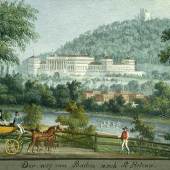Hauser Wirth & Schimmel
Maria Lassnig. A Painting Survey, 1950–2007
-
Ausstellung17.09.2016 - 31.12.2016
Vom 17. September bis 31. Dezember 2016 präsentiert die Galerie Hauser Wirth & Schimmel die erste Einzelausstellung Maria Lassnigs in Los Angeles. Unter dem Titel Maria Lassnig. A Painting Survey, 1950–2007 spannt die Ausstellung einen weiten Bogen zwischen Arbeiten der frühen 1950er Jahre bis zum Tod der Künstlerin und spürt dabei den unterschiedlichen Schaffensperioden sowie der künstlerischen Entwicklung Maria Lassnigs nach.
English
Los Angeles… Beginning 16 September 2016, Hauser Wirth & Schimmel is pleased to present ‘Maria Lassnig. A Painting Survey, 1950 – 2007,’ the first Los Angeles solo exhibition for the acclaimed late Austrian artist. Spanning work made from the 1950s to the end of the artist’s life, this survey traces Lassnig’s evolution from early experiments with abstraction to a richly inventive figuration and the refinement of her ‘body awareness’ paintings, in which she captured physical sensation as felt from within. Lassnig devoted much of her career to recording her physiological states through a direct and unflinching style, believing that ‘truth resides in the emotions produced within the physical shell.’ Pursuing her extraordinary science of the self, Lassnig rendered an oeuvre that has influenced such important younger artists as Martin Kippenberger and Paul McCarthy.
‘Maria Lassnig. A Painting Survey, 1950 – 2007’ will be on view through 31 December 2016. The exhibition has been organized by Peter Pakesch, Chairman of the Maria Lassnig Foundation, Vienna, and Paul Schimmel, Vice-President and Partner, Hauser Wirth & Schimmel. A major international retrospective of works by Lassnig is currently touring Tate Liverpool, Liverpool, England; Kunsten Museum of Modern Art Aalborg, Aalborg, Denmark; Museum Folkwang, Essen, Germany; and the National Gallery, Prague, Czech Republic, through 2018. A 2017 retrospective of Lassnig’s works on paper will travel from the Albertina, Vienna, Austria to Kunstmuseum Basel, Basel, Switzerland.
About the Exhibition
‘Maria Lassnig. A Painting Survey, 1950 – 2007’ reveals the ways in which the artist drew from and challenged conventions of abstraction to create a singular figuration.
Organized chronologically, the exhibition unfolds over five rooms, beginning with the early 1950s. In such rarely seen oil paintings as the 1953 works ‘Flächenteilung Schwarz-Weiß-Grau 2’ and ‘Flächenteilung Schwarz-Weiß-Grau 1,’ viewers can see Lassnig exploring an abstract visual language bolstered by her immersion in French avant-garde circles and her relationships with such writers as Paul Celan, Friederike Mayröcker, and Oswald Wiener.
By the late 1950s and early 1960s, Lassnig’s work had turned to gestural, field-like abstract landscapes, exemplified by ‘Tachismus 4’ (1958/1959) and ‘Untitled’ (ca. 1960), in which her earlier subdued palette is replaced by intense, warm color. At the same time, an innovative figuration, expressive and painterly, is beginning to emerge. In such canvases as ‘Selbstporträt als Tier’ (1963) and ‘Balancing Myself’ (1965), Lassnig trains her eye upon herself, offering up works that are caricatured, allegorical, and psychologically penetrating. Her intense color palette in this period, with hot pinks and florid purples and reds, is deliberately unnatural, provoking a re-evalutation of the figure-ground relationship.
In the 1970s, Lassnig turns to a subtler, cooler, but equally surreal palette to portray recognizable nude figures, including the two self-portraits on view ‘Dreifaches Selbstporträt/New Self’ (1972) and ‘Selbstporträt mit Weinglas’ (1975). These depictions of solitude give way in the 1980s to figures barely recognizable as human, but whose raw vulnerability is instantly legible as Lassnig’s. By the end of the decade, the artist’s ongoing exploration of figure-ground tensions is expressed in such works as ‘Große Flächenteilung/Spiegel’ (1989) and ‘Unterbrechung’ (1989), in which simple shapes are painted over horizontal swaths of intense and even acrid contrasting color fields.
The last room of the exhibition presents works from 1990s and 2000s. Here Lassnig has moved from an agitated, intense palette to cool, vivid, and complementary hues. Fragmented figures in some works – ‘Generationsfußtritt/Generationsprobleme II’ (1998/99) and ‘Be-Ziehungen VI’ (1994), for example – seem to suggest the artist confronting questions of knowledge, language, and generational conflict. Other canvases on view, painted in this final period of Lassnig’s life, reflect tender and personal moments – a figure kissing a teddy bear, a self-portrait blowing a bubble.
-
Horst und Wolfgang Szaal über die Entwicklung der Galerie Szaal im Spiegel der Jahrzehnte In...
-
17.09.2016 - 31.12.2016
Wednesday, Friday – Sunday: 11 am – 6 pm
Thursday: 11 am – 8 pm










